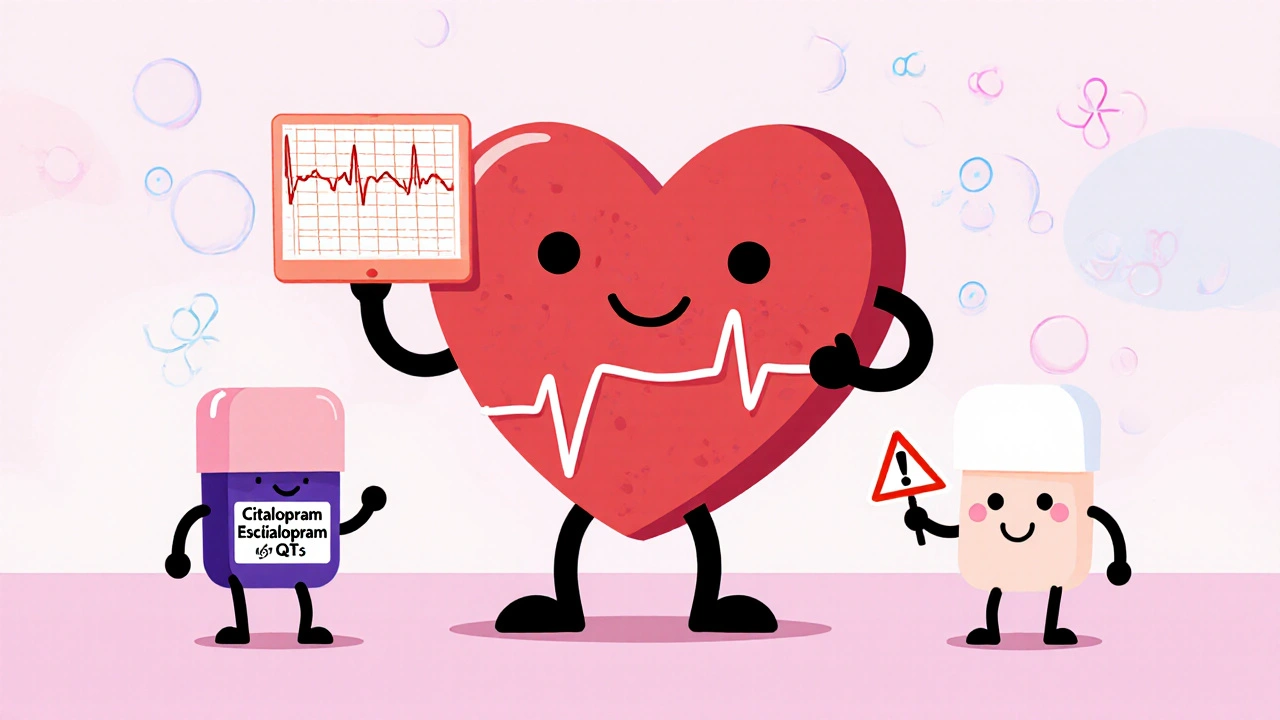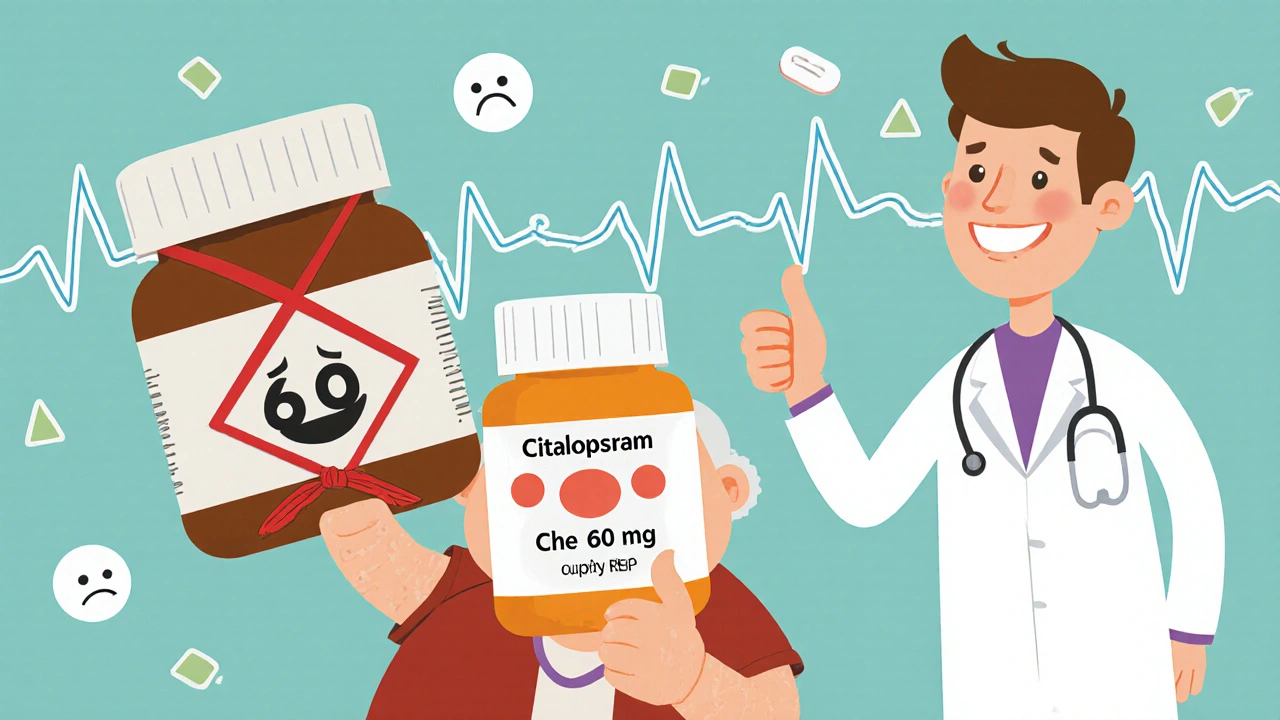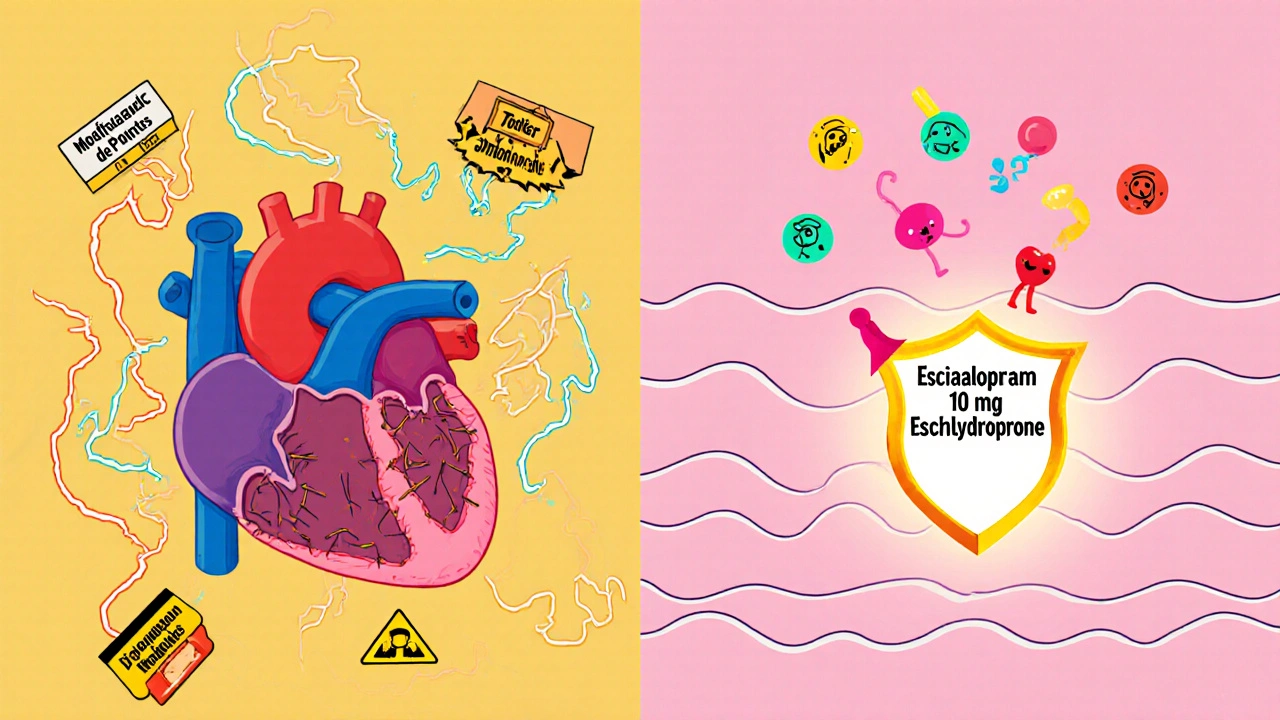
QT Prolongation Risk Calculator
Drug Dose Calculator
Results
Note: This is a simplified estimate based on clinical data. Actual risk depends on individual factors including electrolyte levels, other medications, and heart conditions.
When you're prescribed an antidepressant, you're not just thinking about mood improvement-you're also thinking about your heart. That’s especially true for citalopram and escitalopram, two commonly used SSRIs that carry a quiet but serious risk: QT prolongation. This isn’t a theoretical concern. It’s a real, measurable change in your heart’s electrical rhythm that can, in rare cases, lead to life-threatening arrhythmias. The FDA, MHRA, and other global health agencies took action in 2011 because the data was clear: higher doses of these medications stretch the QT interval, and that stretch matters.
What Exactly Is QT Prolongation?
Your heart beats because of electrical signals. The QT interval on an ECG measures how long it takes for the heart’s ventricles to recharge between beats. If that interval gets too long, your heart can slip into an abnormal rhythm called Torsade de Pointes-a fast, chaotic beat that can turn into ventricular fibrillation and cause sudden cardiac arrest. It’s rare, but it’s deadly when it happens.
Citalopram and escitalopram both block a specific potassium channel in heart cells called hERG. That’s how they help with depression-by increasing serotonin in the brain-but it’s also how they interfere with the heart’s natural timing. Slower potassium flow means slower repolarization. That’s QT prolongation.
Dose Matters-A Lot
Not all doses are equal. The risk isn’t linear; it spikes with higher doses. Here’s what the data shows:
- Citalopram 20 mg/day: QTc increases by about 8.5 milliseconds
- Citalopram 40 mg/day: QTc increases by 12.6 milliseconds
- Citalopram 60 mg/day: QTc increases by 18.5 milliseconds
For escitalopram, the numbers are lower-but still present:
- Escitalopram 10 mg/day: QTc increases by 4.5 milliseconds
- Escitalopram 20 mg/day: QTc increases by 6.6 milliseconds
- Escitalopram 30 mg/day: QTc increases by 10.7 milliseconds
These aren’t just numbers on a chart. A 10-millisecond increase is noticeable. An 18-millisecond jump? That’s a red flag. Regulatory agencies define clinical concern as a QTc interval longer than 500 milliseconds-or a change from baseline of 60 milliseconds or more. Even if you start at a normal QTc of 440 ms, a 60 ms increase puts you at 500 ms. That’s the threshold where the risk of dangerous arrhythmias starts climbing.
Why Citalopram Is Riskier Than Escitalopram
Citalopram is a mix of two mirror-image molecules (enantiomers): R and S. Only the S-form is active for serotonin reuptake. The R-form does nothing for depression-but it still blocks the hERG channel. That means citalopram delivers a double hit: the S-form helps your mood, and the R-form quietly slows your heart’s recovery.
Escitalopram is just the S-form. No extra baggage. That’s why it’s cleaner, safer, and why most guidelines now favor it-especially for patients with heart risks.
Studies show the difference isn’t huge, but it’s real. At 40 mg, citalopram pushes QTc further than escitalopram at 20 mg. And at 60 mg? That’s where citalopram becomes dangerous. The FDA explicitly warned against doses above 40 mg for citalopram in 2011. That’s not a suggestion-it’s a hard limit.

Regulatory Limits: What You’re Allowed to Take
After the 2011 safety reviews, regulators didn’t just issue warnings-they set hard caps:
- Citalopram: Max 20 mg/day for patients over 65; max 40 mg/day for adults under 65
- Escitalopram: Max 10 mg/day for patients over 65; max 20 mg/day for adults under 65
These aren’t arbitrary. Older adults metabolize drugs slower. Their kidneys and liver don’t clear medications as efficiently. That means even standard doses can build up to dangerous levels. A 20 mg dose of citalopram in a 70-year-old could have the same blood concentration as 40 mg in a 30-year-old.
Some countries, like the UK, applied these limits to both drugs. Others, like the U.S., focused more on citalopram. But the science supports the stricter approach: if you’re going to err, err on the side of caution.
Who’s at Highest Risk?
Not everyone taking these drugs needs an ECG. But some people absolutely do. You’re at higher risk if you have:
- Pre-existing QT prolongation or congenital long QT syndrome
- Heart failure or recent heart attack
- Bradycardia (slow heart rate)
- Low potassium or low magnesium levels
- Liver disease (impaired metabolism)
- Are taking other QT-prolonging drugs
Common culprits that stack the risk? Antibiotics like moxifloxacin, antifungals like fluconazole, antiarrhythmics like amiodarone, and even some antipsychotics. Even over-the-counter antihistamines like diphenhydramine can add to the burden.
If you’re on any of these, your doctor should check your QT interval before starting citalopram or escitalopram-and maybe again after a few weeks.

What About Other Antidepressants?
Not all SSRIs carry this risk. Fluoxetine, sertraline, and paroxetine have minimal effects on QT. SNRIs like duloxetine and venlafaxine are mostly safe at standard doses-though venlafaxine overdose can be dangerous. Tricyclic antidepressants like amitriptyline? They’re worse than citalopram for QT prolongation. So if you’re switching because of cardiac concerns, you’re not necessarily trading one risk for another.
For most patients, escitalopram at 10-20 mg is a safer choice than citalopram at 40 mg. It’s more expensive, yes-but if you’re 68 and have a history of high blood pressure, the cost is worth avoiding a trip to the ER.
Is the Risk Actually High?
Let’s be clear: Torsade de Pointes from these drugs is rare. Most people take them without issue. The risk is low-but not zero. And when it happens, it’s often sudden. No warning. No pain. Just a stopped heart.
That’s why guidelines say: don’t ignore the numbers. Don’t assume "it won’t happen to me." The data is too consistent. The dose-response curve is too clear. The regulatory actions were too global.
Studies published after 2011 show that when doctors followed the new dose limits, serious events dropped. That’s not coincidence. It’s proof that these limits save lives.
What Should You Do?
If you’re currently on citalopram at 40 mg or higher: talk to your doctor. Don’t stop abruptly. But do ask: Is this dose necessary? Could escitalopram work just as well at a lower dose?
If you’re over 65 and on any SSRI: ask if your dose is appropriate. Many older adults are still on outdated doses.
If you’ve had a recent ECG: check your QTc. If it’s over 450 ms in men or 460 ms in women, that’s a signal to be cautious. If it’s over 500 ms, you should not be on citalopram or escitalopram at all.
If you’re starting treatment: ask your doctor if they’ve checked your cardiac history and electrolytes. If they haven’t, it’s worth asking why.
Antidepressants are powerful tools. But they’re not risk-free. The goal isn’t to scare you off them-it’s to use them wisely. The right dose, the right patient, the right monitoring. That’s how you get the benefit without the danger.
Can I still take citalopram if I’m over 65?
Yes, but only at 20 mg per day or less. Higher doses significantly increase the risk of QT prolongation in older adults due to slower metabolism. Always confirm with your doctor that your dose is appropriate for your age and kidney/liver function.
Is escitalopram safer than citalopram for the heart?
Yes. Escitalopram contains only the active S-enantiomer, which means it doesn’t carry the extra cardiac risk from the R-enantiomer found in citalopram. At equivalent doses, escitalopram causes less QT prolongation. For patients with heart conditions or risk factors, escitalopram is generally preferred.
What’s the maximum safe dose of escitalopram?
For adults under 65, the maximum recommended dose is 20 mg per day. For those 65 and older, it’s 10 mg per day. Doses above these levels increase QT prolongation risk without clear added benefit for depression.
Should I get an ECG before starting these medications?
If you have any heart condition, are over 65, take other QT-prolonging drugs, or have electrolyte imbalances, yes. A baseline ECG helps establish your normal QTc. Follow-up ECGs may be needed after dose changes or if you develop symptoms like dizziness or fainting.
Can I take citalopram or escitalopram with other antidepressants?
Combining SSRIs or mixing them with other drugs that prolong QT-like certain antipsychotics, antibiotics, or antiarrhythmics-can dangerously increase your risk. Never combine these medications without explicit direction from your doctor and monitoring of your heart rhythm.
Do these drugs cause QT prolongation in everyone?
No. Most people tolerate them without issue. But the risk is dose-dependent and influenced by age, genetics, and other medications. Even if you feel fine, the effect on your heart’s electrical system can still be happening. That’s why dose limits and screening matter.
Comments (14)
-
Melvina Zelee November 24, 2025
man i just started escitalopram last month at 10mg and was totally unaware of the qt thing. glad i read this before bumping up the dose. my grandma had a bad heart rhythm thing years ago, so now i’m extra cautious. thanks for laying it out like this.
-
Patrick Marsh November 25, 2025
40 mg citalopram is a hard limit. Not a suggestion. Not a guideline. A limit.
-
Mark Williams November 26, 2025
hERG channel blockade is the key mechanism here-potassium efflux inhibition leads to prolonged repolarization phase 3 of the cardiac action potential. The enantiomeric purity of escitalopram reduces off-target cardiac liability by ~40% compared to racemic citalopram. Pharmacokinetic modeling shows Cmax and AUC of R-citalopram correlate directly with QTc prolongation in a non-linear fashion.
-
Holly Schumacher November 27, 2025
Of course no one talks about how the FDA only acted because someone died on 60mg. They wait until there’s blood on the floor before they do anything. And now they’re punishing everyone else because one person didn’t listen.
-
Miruna Alexandru November 27, 2025
It’s fascinating how the R-enantiomer of citalopram, pharmacologically inert in terms of serotonin reuptake inhibition, retains full affinity for the hERG potassium channel-a perfect example of molecular promiscuity with lethal consequences. This is not a case of dose-dependent toxicity; it’s a case of structural toxicity masked as therapeutic equivalence. The regulatory response was tepid, but scientifically sound.
And yet, clinicians still prescribe 40mg citalopram like it’s a placebo, ignoring the fact that the QTc delta exceeds 18ms at that dose-well beyond the 60ms absolute threshold for clinical concern. This isn’t risk management. It’s negligence dressed in clinical inertia.
The fact that escitalopram is preferred isn’t just about efficacy-it’s about eliminating a toxic isomer. Why are we still prescribing racemic mixtures when enantiopure alternatives exist? The answer isn’t science. It’s cost, inertia, and institutional blindness.
And don’t get me started on the elderly. A 20mg dose in a 70-year-old with reduced CYP2C19 activity is functionally equivalent to a 40mg dose in a 30-year-old. Yet, we still see prescriptions for 30mg in patients with renal impairment. This isn’t medical practice. It’s gambling with a loaded gun.
The data has been clear since 2011. The guidelines are published. The ECG recommendations are standard. So why do we still see patients on dangerous doses? Because we prioritize convenience over caution. Because we assume ‘it won’t happen to me.’ And that’s the most dangerous assumption in pharmacology.
-
Ravi Kumar Gupta November 27, 2025
in india we still see citalopram 40mg being given like candy. doctors don't even check ecg. my uncle took it for 3 years at 40mg and never had an issue-but now he has atrial fibrillation. is it because of the drug? maybe. but nobody cares. we don't have the luxury of checking QT intervals like you folks do.
-
Justin Daniel November 28, 2025
so basically: escitalopram 10mg = good. citalopram 40mg = bad. and if you're over 65? just stick to 10mg of the good one. also, don't mix with antihistamines. i learned that the hard way after taking benadryl for a cold and feeling like my heart was gonna explode. lol.
-
ann smith November 29, 2025
Thank you for sharing this with such clarity. 💙 I’ve been on escitalopram for 2 years now at 10mg and never knew about the QT details-this is the kind of info that helps people feel empowered, not scared. Please keep educating like this. Your post could literally save someone’s life.
-
Shawn Daughhetee November 30, 2025
my doc never mentioned any of this. i'm on 20mg escitalopram and i'm 67. should i be worried? i've got high bp but no other heart stuff. just wondering.
-
Daniel Jean-Baptiste December 2, 2025
glad this got posted. i had no idea the r-enantiomer was the problem. my cousin took citalopram for years and now has a pacemaker. nobody connected the dots until now. maybe we need a warning label on the bottle. like 'this may slow your heart down more than you think'
-
Julie Pulvino December 3, 2025
just read this after my cardiologist asked if i was on any antidepressants. i was about to ask my psych to bump me to 20mg escitalopram. now i’m pausing. thanks for the nudge to be careful. i’ve got a family history of arrhythmias, so this hits home.
-
james lucas December 4, 2025
so if you’re over 65 and on citalopram 20mg, you’re still in the danger zone? i thought 20 was safe. i’m confused now. my doctor said it was fine but now i’m reading this and i’m like… wait what?
-
Latonya Elarms-Radford December 6, 2025
Oh, so now we’re treating depression like a nuclear reactor? We’ve gone from ‘talk about your feelings’ to ‘get an ECG before you take your morning pill’? It’s absurd. We’ve turned mental health into a minefield of regulatory paranoia. People are terrified to take medication because every drug is now a potential cardiac grenade. And the irony? The people who need these meds the most-the ones drowning in despair-are the ones who’ll avoid them out of fear. We’ve created a system where safety is weaponized against healing.
Let’s be real: Torsade de Pointes from SSRIs is rarer than being struck by lightning while winning the lottery. But because one person died, we’ve made millions feel like criminals for seeking relief. This isn’t medicine. It’s fearmongering dressed in scientific jargon.
And don’t get me started on the ‘escitalopram is safer’ narrative. It’s the same molecule, just filtered. The difference in QT prolongation is statistically significant but clinically negligible. Yet we’ve created a two-tier system where the expensive version is ‘better’-because of marketing, not medicine.
Stop scaring people. Start trusting them. And for god’s sake, stop turning every antidepressant into a life-or-death calculus. Depression kills faster than any arrhythmia ever could.
-
Nikhil Chaurasia December 7, 2025
i've been on 10mg escitalopram for 4 years. never had an ecg. never had any symptoms. i'm 58. maybe i'm just lucky. but if my doctor didn't mention this, how many others are in the dark? i think we need better education for both docs and patients. not more fear.
